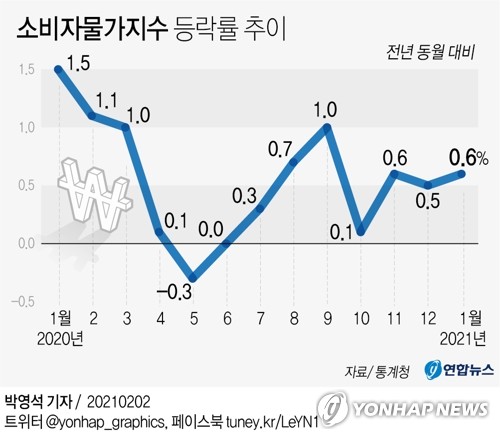Eggs 15.2%↑, livestock products 11.5%↑… Agricultural and fishery products rise, industrial products decline
Point out the gap with the shopping cart price… “Services, etc. are lowered, so on average, it is around 0%”
![[그래픽] Consumer price index fluctuations](https://i0.wp.com/img2.yna.co.kr/etc/graphic/YH/2021/02/02/GYH2021020200020004400_P2.jpg?w=560&ssl=1)
(Seoul = Yonhap News) Reporter Park Young-seok = According to the consumer price trend of the National Statistical Office on the 2nd, the consumer price index for January was 106.47 (2015 = 100), up 0.6% from the same month last year. [email protected]
(Sejong = Yonhap News) Reporter Lee Bo-bae Su-yeon Su-yeon and Kwak Min-seo = Consumer inflation has remained at the 0% level for four consecutive months.
Policy factors such as a cut in electricity rates and a decline in industrial products had an effect on low inflation, but the’shopping cart prices’ experienced by the public, such as agricultural and livestock products, increased significantly.
◇ Consumer price 0.6%↑… Livestock products, such as 11.5%↑
According to the consumer price trend of Statistics Korea on the 2nd, the consumer price index for January was 106.47 (2015 = 100), up 0.6% from the same month last year.
From October last year (0.1%), November (0.6%), December (0.5%), and January this year (0.6%), the rate of increase was around 0% for four consecutive months.
Compared to the previous month, consumer prices rose 0.8%, the largest increase since September 2018 (0.8%).
The rise in consumer prices was largely due to the increase in agricultural and marine products.
Agricultural and aquatic products rose 10.0% from a year ago, showing a high increase since last November (11.1%) and December (9.7%).
In particular, livestock products jumped 11.5% as the supply of eggs and others decreased due to the spread of AI. It is the largest increase in 6 years and 7 months since June 2014 (12.6%).
Eggs rose 15.2%, the most since March last year (20.3%). Pork (18.0%) and domestic beef (10.0%) also raised the rate of increase.
Agricultural products rose 11.2%, of which vegetables rose 3.0%. Apples (45.5%), green onions (76.9%), red pepper powder (34.4%), onions (60.3%), and rice (12.3%) showed high rates of increase.
Industrial products fell 0.6%, but the decline was less than last month (-0.9%) due to the recovery of international oil prices.
Petroleum products fell 8.6%. This also decreased from the previous month (-12.6%). However, processed foods rose 1.6% due to rising raw material prices.
Electricity, water, and gas fell 5.0%.
Prices of agricultural and marine products, industrial products, and commodities including electricity, water and gas rose 0.9%.
The service rose 0.4%, and the increase was smaller than that of the product.
At the beginning of the year, as material costs and labor costs rose, personal service consumer prices rose 1.5%. Among them, the price of dining out was 1.1%, and the inflation rate of personal services other than dining out was 1.8%.
Public services fell 2.1% due to the impact of policies such as free high school payments and support for communication expenses.
The rent rose 0.7% from the previous year, continuing the upward trend for 9 consecutive months since May last year. Jeonse and monthly rent increase rates were 1.0% and 0.4%, respectively.

(Sejong = Yonhap News) Reporter Kim Joo-hyung = Lee Jeong-hyun, head of the National Statistical Office’s Inflation Trend Section, is presenting consumer price trends for January 2021 at the Sejong City Government Complex on the morning of the 2nd. 2021.2.2 [email protected]
◇ Point out the gap with the price of the’murderous’ shopping cart… “The price index is an average concept”
By expenditure, food and non-alcoholic beverages rose by 6.5% as demand for’home food’ continued due to the prolonged new coronavirus infection (Corona 19).
On the other hand, entertainment and culture (-0.8%), communication (-1.3%), education (-2.9%), and transportation (-2.9%) fell.
Excluding agricultural products and petroleum index (root price), which shows the key trend of inflation, rose 0.9%, showing an increase of 0% for two consecutive months.
The food and energy exclusion index rose 0.4%, down from the previous month (0.5%).
The fresh food index also rose 9.2%, slowing the rise from the previous month (10.0%).
However, the living price index, which is a perceived indicator, rose 0.3% and turned positive (+) after four months since September last year (0.9%).
“Life prices are stable in terms of index, but the prices of livestock and fishery products are rising,” said Lee Jeong-hyun, head of the Statistical Office’s inflation trend. “He said.
As the prices of eggs and onions rise sharply, the people’s cries of ‘murderous’ in shopping cart prices, and consumer inflation rates remain at the 0% level, and some point out about the gap between perceived prices and official indicators.
“Because the total price index is an average concept,” said Lee. “Agricultural and fisheries products have risen a lot, but there are areas such as services that are lowered by Corona 19 or policy support, so overall, it shows an increase of 0%.” Explained.
Unauthorized reproduction-redistribution prohibited>
2021/02/02 10:53 sent
